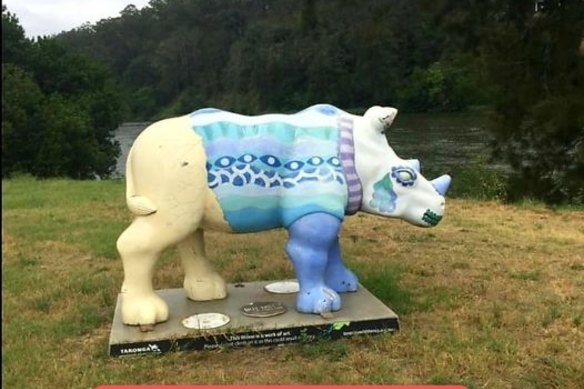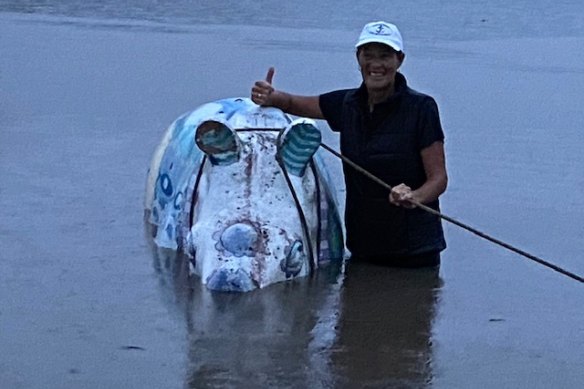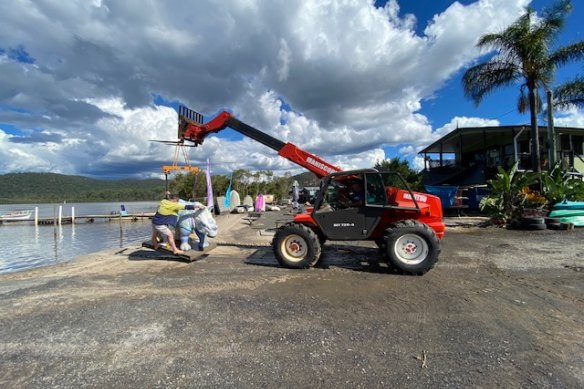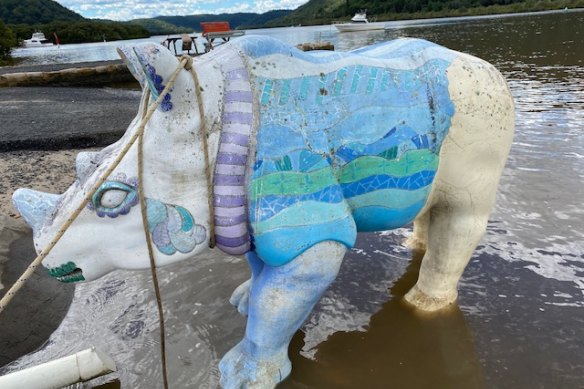This was published 2 years ago
How a 500kg fibreglass rhino named Spenser wandered 18km during the flood
As the water began to rise on the Upper Hawkesbury River last Friday, a 500 kilogram fibreglass rhinoceros named “Spenser” began to stir on the lawn of his Sackville North home. Soon, he was afloat.
The neighbours spotted his colourful form drifting past and three men jumped in a tinny to fish him out, but he was attached to his concrete slab, too heavy to lift, and the river was running fast. They tied their boat to Spenser and were pulled as far as Sackville where they abandoned him to the current.

A 500 kilogram fibreglass rhinoceros named “Spenser” travelled from Sackville to St George during the 2022 flood. Credit: Facebook: Sha Paisley
“It wasn’t worth dying for,” said Lauren Jones, one of the men’s wives.
The floodwaters carried Spenser past St Thomas Cemetery, down the long straight section of the river that is popular with water skiers in the summer, and looped around the hair bend turn. He joined the flotsam of hundreds of farms and homes that line the river and the creeks that feed it – kayaks, styrofoam boxes, water tanks, pieces of caravans, tyres, fridges and tennis balls.
All up and down the coast, as rivers ran their banks and the valleys filled with water, vast amounts of material was picked up in the slurry. In the Northern Rivers, Facebook groups tried to return livestock and pets to their owners, with dogs, cattle, horses and ponies discovered many kilometres downstream.
Robert Tillman lost 15 head of cattle from his property at Ruthven, on the Wilson River south of Lismore. Just one survivor was found, 30 kilometres south.
Some of the cows Mr Tillman lost were in calf, and due to give birth next week. “It’s something that will hit me down the track,” he said. “Some time in the next three months, we will all sit down and have a good cry and get on with it.”
But it could have been worse. One of his neighbours lost 30 cattle to the floods. Some lost beloved horses. Another neighbour’s whole house was picked up by the floodwaters and floated for 50 metres before becoming entangled in the she-oaks and gums that lined the river bank.
They lost toolboxes in Ballina and surfboards at East Wardell. Somebody at Pimlico on the Richmond River found an Australian army security trunk full of photos, tapes and keepsakes, owner unknown.
Spenser continued to drift through the water ski parks. It was not his first experience of the Hawkesbury. During his maiden voyage in the floods last year, he travelled more than 60 kilometres to wash up at Spencer, which became his namesake. He needed a crane to winch him from the water. Afterwards, his owner drilled holes in him to ensure he did not float.

Spenser the rhinoceros being retrieved from Spencer in 2021.Credit: Donna Buchanan.
Spenser had other ideas.
The Hawkesbury River is fed by hundreds of creeks, as well as the flow from Warragamba Dam and, in the lower Hawkesbury, Mangrove Mountain. By late last week, it was a giant morass, with debris collecting in the eddies and washing up on the bends.
During the 2021 flood, when the mass of water came from Warragamba Dam, the water rose so quickly that dangerous eddies were formed. Ms Jones saw an unmanned kayak come down and become sucked under the water by an eddy, before shooting up like a knife into the air. This time the water rose more slowly as it was fed by the rain. She saw an outdoor lounge set come down in pieces.
On Tuesday, she and her husband Simon came home to find that their pontoon was missing from the end of the jetty. Lauren put out an alert on social media and within 20 minutes it was reported to have floated past Lower Portland, about 17 kilometres downstream, followed by further sightings all the way down the river.

Spenser needed a crane to be rescued from the 2021 floods. Credit: Donna Buchanan.
“It really went viral in our little community – not viral by global standards – and then someone found it at Brooklyn and posted it on another page,” Ms Jones said.
Ms Jones had never been to Brooklyn, which was nearly 80 kilometres away by river. No sooner had she identified the pontoon than a looter was reported to be aboard. A man from Brooklyn Marina went out on his boat and secured the pontoon until Mr Jones could collect it the next day.
“These people don’t know us and they were so lovely.” When her husband went to collect it on Thursday, he took five cases of beer to deliver among the pontoon’s rescuers.
Greg Twemlow lives at Little Wobby Beach, opposite Brooklyn on the main channel of the Hawkesbury before it spills into Broken Bay. The debris that survives long enough to reach his part of the river is often designed to be buoyant, such as water skis and life jackets, though he has also seen dead animals. He said 90 per cent of the material that floated past was man-made. Sometimes the locals rescue animals such as echidnas, possums and snakes are floating on the logs.

Spenser the rhino has been on two river journeys in as many years. Credit: Donna Buchanan.
“The seagulls and ducks love it,” he said. “They get a free ride down the river.”
Last year he saw a green channel marker float by and took a note of its number, which placed its origin at the Upper Colo. Some days later he saw it again in a photo taken by the lifeguards at Bondi Beach.
By Tuesday, pumpkins from the Hawkesbury farms were washing up in their dozens on Patonga Beach, which faces the open ocean at the mouth of Broken Bay. On Thursday, Graham Johnston, who runs Clean4Shore, pulled out a mobile canteen that floated to Patonga from Sackville, along with 32 pieces of polystyrene cladding that might have come from cool rooms or caravans, seven water tanks, six large drums, four buckets, two milk crates, two water skis and hundreds of pieces of plastic and styrofoam.
“There’s probably more rubbish now than the flood in 2021,” he said.
But all that was yet to unfold last Friday, when Spenser eased to a halt at St George, 18 kilometres from his starting point, a mere fraction of his 2021 voyage. He was photographed half-submerged and surrounded by trees, with branches grazing his rump.
The locals joked that he thought he was a hippo, that he was looking for Africa, that he had done more travelling in the past two years than they had. They told the owners to keep their rhino on a leash.
When the waters started to rise again, Spenser was lodged behind a tree.
A guide to the environment, what’s happening to it, what’s being done about it and what it means for the future. Sign up to our fortnightly Environment newsletter here.